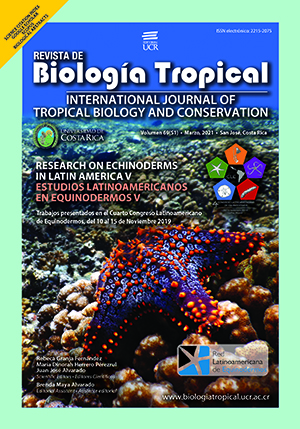Abstract
Introduction: Cassiduloids play a prominent role in echinoid evolutionary history because they probably are the ancestral group of clypeasteroids. Some extant species are brooding and rare in the environment. Consequently, there are no studies on their maintenance in the laboratory. Objective: Establish an efficient aquarium system for C. mitis, endemic to Brazil, for ontogenetic studies. Methods: Four aquarium systems were built, with 3 replicates each one: (1) with seawater flow [F]; (2) with seawater flow and air injection into sediment [FA]; (3) without seawater flow but with air injection into the sediment [A]; and (4) without both seawater flow and air injection into the sediment [C]. Each experimental aquarium (three per treatment) had two adults. Each of the two sets of experiments lasted about 60 days. Results: We observed low mortality in the first 30 days in all systems and, after 30 days, it was higher in those with air-pumped into the sediment (system A in the first set of experiments, and system FA in the second one). Conclusions: For experiments lasting 30 days, our four systems are suitable. For longer periods, we recommend aquaria with seawater flow and without air-pumps into the sediment.
References
Brito, I.M. (1981). Equinoides fósseis do Brasil II - os holectipoides e cassiduloides. Anais da Acadêmia Brasileira de Ciências. 53(3), 513-527.
Brito, I.M. & Ramires, L.V. (1974). Contribuição ao conhecimento dos equinoides albianos (Cretáceo Inferior) do Brasil. Anais da Acadêmia Brasileira de Ciências. 46(2), 275-282.
Claus, C. F.W. 1880. Grundzüge der Zoologie. 4th edition. N. G. Elwertsche Universit¨atsbuchhandlung, Marburg & Leipzig, vol. 1, vii + 821 pp., vol. 2, iv + 522 pp.
Contins, M. & Ventura, C.R.R. (2011). Embryonic, larval, and post-metamorphic development of the sea urchin Cassidulus mitis (Echinoidea; Cassiduloida): An endemic brooding species from Rio de Janeiro, Brazil. Marine Biology, 158(10), 2279-2288.
Freire, C.A.; Santos, P.J.P.; Fontoura, N.F.; Magalhães, R.A.O. & Grohmann, P.A. (1992). Growth and spatial distribution of Cassidulus mitis (Echinodermata: Echinoidea) on a sandy beach in Southeastern Brazil. Marine Biology, (112), 625-630.
Gladfelter, W.B. (1978). General ecology of the cassiduloid urchin Cassidulus caribbearum (sic). Marine Biology, 47(2): 149-160.
Heyland, A., Schuh, N. & Rast, J. (2018). Sea urchin larvae as a model for postembryonic development. Chapter 8. In: Kloc, M. & Kubiak, J. Z. (Eds), Marine organisms as model systems in Biology and Medicine. (pp 137-161). Springer, Gewerbestrass, Switzerland. 624 p.
Kier, P.M. (1962). Revision of the cassiduloid echinoids. Smithsonian Miscellaneous Collections, 114(3), 1262 p.
Krau, L. (1954). Nova espécie de ouriço-do-mar: Cassidulus mitis, ordem Cassiduloida, Echinoidea, capturado na Baía de Sepetiba. Memórias do Instituto Oswaldo Cruz, (52), 455-475.
Krebs, C. (2017). Estimation of survival rates. In: Benjamin Cummings (Ed) Ecological Methodology (pp. 655-698). Chapter 15. 3rd edition, University of California, 768 p.
Kroh, A. & Mooi, R. (2020). World Echinoidea Database. Cassidulus Lamarck, 1801. Accessed through: World Register of Marine Species at http://www.marinespecies.org/aphia.php?p=taxdetails&id=512626 on 2020-08-29
Lamarck, J. B. (1801). Système des animaux sans vertèbres, ou tableau général des classes, des ordres et des genres de ces animaux; Présentant leurs caractères essentiels et leur distribution, d’après la considération de leurs rapports naturels et de leur organisation, et suivant l’arrangement établi dans les galeries du Muséum d’Histoire Naturelle, parmi leurs dépouilles conservées; Précédé du discours d’ouverture du Cours de Zoologie, donné dans le Muséum National d’Histoire Naturelle l’an 8 de la République. Published by the author and Deterville, Paris: viii + 432 pp.
MacCord, F. S. & Ventura, C. R. R. (2004). Reproductive cycle of the endemic cassiduloid Cassidulus mitis (Echinoidea: Cassiduloida) on the Brazilian coast. Marine Biology, (145): 603–612.
Märkel, K. (1978). On the teeth of the recent Cassiduloid Echinolampas depressa Gray, and on some Liassic fossil teeth nearly identical in structure (Echinodermata, Echinoidea). Zoomorphologie, (89), 125-144.
Mooi, R. (1990a). Living cassiduloids (Echinodermata: Echinoidea): a key and annotated list. Proceedings of the Biological Society of Washington, 103(1). 63-85.
Mooi, R. (1990b). A new “living fossil” echinoid (Echinodermata) and the ecology and paleobiology of Caribbean cassiduloids. Bulletin of Marine Science, 46(3), 688-700.
Mortensen, T. (1948). Holectypoida, Cassiduloida In: T. Mortensen, A Monography of the Echinoidea 4(1) C.A. Reitzel, Copenhagen, 371 p.
Pearse, J.S. & Cameron, R.A. (1991) Echinodermata: Echinoidea. In: A. C. Giese, J.S. Pearse & V. B. Pearse. Reproduction in Marine Invertebrates. Vol. VI. Echinoderms and Lophophorates. Chapter 7. 513-662 p. The Boxwood Press, Pacific Groove, California, 808 p.
Raff, R. A. & Byrne, M. (2006). The active evolutionary lives of echinoderm larvae. Heredity, (97),244-252.
Schopf, T.J.M. (1984). Rates of evolution and the notion of “living fossil”. Annual Review of Earth and Planetary Science, (12), 245-292.
Smith, A. B. (2001). Probing the cassiduloid origins of clypeasteroid echinoids using stratigraphically restricted parsimony analysis. Paleobiology, (27),392-404.
Smith, A. B. & Bengston, P. (1991). Cretaceous echinoids from north-eastern Brazil. Fossils and Strata. (31):1-88.
Squires, R.L. & Demetrion, R.A. (1995). A new genus of cassiduloid echinoid from the Lower Eocene of the Pacific Coast of Western North America and a new report of Cassidulus ellipticus Kew, 1920, from the Lower Eocene of Baja California Sur, Mexico. Journal of Paleontology, 69(3), 509-515.
Tahara, Y., Okada, M. & Kobayashi, N. (1958) Secondary sexual characters I Japanese sea-urchins. Publications of the Seto Marine Biological Laboratory, 8: 183-189.
Telford, M. & Mooi, R. (1996). Podial particle picking in Cassidulus caribaearum (Echinodermata: Echinoidea) and the Phylogeny of sea urchin feeding mechanisms. Biological Bulletin, (191), 209-223.
Tommasi, L.R. & Lima-Verde, J.S. (1970). Observações sobre Cassidulus mitis Krau, 1960 (Cassiduloida, Echinoidea). Boletim do Instituto Oceanográfico. Universidade de São Paulo, 18(1), 1-9.
Wagner, P.J. (2000). Exhaustion of morphologic character states among fossil taxa. Evolution (54), 365-386.
##plugins.facebook.comentarios##

This work is licensed under a Creative Commons Attribution 4.0 International License.


